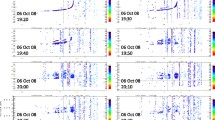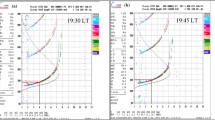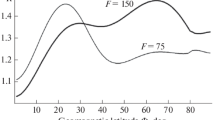Abstract
Determining the morphology of F-layer irregularities as a function of longitude in the equatorial region is vital for understanding the physics of the development of these irregularities. We aim to lay the observational basis which then can be used to test theoretical models. Theoretical models have been developed, notably in the papers by Tsunoda (1985) and by T. Maruyama and N. Matuura (1984). The question is whether the models are consistent with the morphology as we see it.
According to our criteria, the data used should be confined to observations taken near the magnetic equator during quiet magnetic periods and at times within a few hours after sunset. Anomaly region scintillation data have to be used in a limited manner for studying the generation mechanism.
The questions to be answered by proposed mechanisms are (1) why do the equinox months have high levels of occurrence over all longitudes and (2) why are there relatively high levels of occurrence in the Central Pacific Sector in the July–August period and in the 0–75° West Sector in the November-December period and (3) why are there very low levels of occurrence in November and December in the Central Pacific Sector and in July and August in the 0–75° West Sector.
In the paper by Maruyama and Matuura, the authors have taken observations of topside soundings of spread-F. With this data set in hand, they conclude: “During the northern winter periods, there is maximum enhancement at the Atlantic longitudes of large westward geomagnetic declination and during the northern summer at the Pacific longitude of large eastward declination”.
Tsunoda's conclusions from his use of scintillation data is that “scintillation activity appears to maximize at times of the year when the suset nodes occur”. The emphasis of one paper is on the maximum enhancement during the solstices and in the other paper on variations from the equinox as determined by latitude and declination. Each stresses certain characteristics of the morphology. While the two papers explain relatively different morphologies, each makes contributions. However there remain problems to be resolved before certifying a solution as to the physics explaining the longitudinal pattern of F-region irregularities.
Satellitein-situ data, scintillation and spread-F observations will be reviewed. The limitation of each data set will be outlined particularly as relevant to the bias produced by the existence of thin versus extended layers of irregularities. A cartoon as to the occurrence pattern, as we see it, as a function of longitude will be shown.
Similar content being viewed by others
References
Aarons, J., Mullen, J. P., Koster, J. P., daSilva, R. F., Madeiros, J. R., Madeiros, R. T., Bushby, A., Pantoja, J., Lanat, J., and Paulson M. R.: 1980, ‘Seasonal and geomagnetic control of equatorial scintillations in two longitudinal sectors’,J. Atmos. Terr. Phys. 42, 861–866.
Aarons, J.: 1991, ‘The role of the ring current in the generation or inhibition of equatorial F-layer irregularities during magnetic storms’,Radio Sci. 26, 1131–1149.
Abdu, M. A., Bittencourt, J. A., and Batista, I. S.: 1981, ‘Magnetic declination control of equatorial F region dynamo electric field development and Spread-F’,J. Geophys. Res. 86, 11442–11446.
Aggson, T. L., Lurke, W. J., Maynard, N. C., Hanson, W. B., Anderson, P. C., Slavin, J. A., Hoegy, W. R., and Saba, J. L.: 1992, ‘Equatorial bubbles updrafting at supersonic speeds’,J. Geophys. Res. 97, 8581–8590.
Basu, S. and Aarons, J.: 1977, ‘Equatorial irregularity campaigns Part 1: Correlated scintillation and radar backscatter measurements in October 1976’, AFGL, Hanscom AFB, MA, AFGL-TR-0264 #617.
Basu, S., Basu, Su., Aarons, J., McClure, J. P., and Cousins, M. D.: 1978, ‘On the coexistence of kilometer and meter scale irregularities in the nighttime equatorial F-region,’J. Geophys Res. 83, 4219.
Basu, S., Basu, Su., Valladares, C. E., DasGupta, A., and Whitney, H. E.: 1986, ‘Scintillations associated with bottomside sinusoidal irregularities in the equatorial F-region’,J. Geophys. Res. 91, 270–276.
Basu, S., MacKenzie, E., Basu, Su., Costa, E., Fourger, P. F., Carlson, H. C., and Whitney, H. E.: 1987, ‘250 MHz/GHz Scintillation parameters in the equatorial, polar and auroral environments’,IEEE J. on Selected Areas in Communications, v. SAC-5, 102–115.
Basu, Su.: 1978, ‘OGO-6 observations of small scale irregularity structures associated with subtrough density gradients’,J. Geophys. Res. 83, 182–190.
Basu, Su., MacKenzie, E., and Basu, S.: 1988, ‘Ionospheric constraints on VHF/UHF communication links during solar maximum and minimum periods’,Radio Science 23, 363–378.
Buonsanto, M. J., Northcott, R. L., Wright, R. W. H.: 1987, ‘Rapid fluctuations in ionospheric Faraday rotation angle and 4 GHz amplitude scintillation observed at Suva, Fiji’,Annales Geophysicae,5A(1), 39–46.
Burke, W. J.: 1979, ‘Plasma bubbles near the dawn terminator in the topside ionosphere’,J. Planet. Space Sci. 27, 1187–1193.
Cohen, R. and Bowles, K. L.: 1961, ‘On the nature of equatorial spread-F’,J. Geophys. Res. 66, 1081–1106.
Cragin, B. L., Valladares, C. E., Hanson, W. B., and McClure, J. P.: 1985, ‘Bottomside sinusoidal irregularities in the equatorial F-region, 2. Cross-correlation and spectral analysis’,J. Geophys. Res. 90, 1721–1734.
DasGupta, A., Aarons, J., Klobuchar, J. A., Basu, Sa., and Bushby, A.: 1982, ‘Ionospheric electron content depletions associated with amplitude scintillations in the equatorial region’,Geophys. Res. Lett. 9, 147–150.
DasGupta, A., Basu, S., Aarons, J., Klobuchar, J. A., Basu, S., and Bushby, A.: 1983, ‘VHF amplitude scintillations and associated electron content depletions as observed at Arequippa, Peru’,J. Atmos. Terr. Phys.,45, 15–26.
DaGupta, A., Maitra, A., and Das, S. K.: 1985, ‘Postmidnight equatorial scintillation activity in relation to geomagnetic disturbances’,J. Atmos. Terr. Phys. 47, 911–916.
Huang, Chun-Ming: 1970, ‘F-Region irregularities that cause scintillations and spread-F at low latitude’,J. Geophys. Res. 75, 4833–4841.
Koster, J. R.: 1972, ‘Equatorial scintillation’,J. Planet. Sp. Sci. 10, 1999–2014.
Livingston, R. C.: 1980, ‘Comparison of multi-frequency equatorial scintillation: American and Pacific sectors’,Radio Sci. 15, 801.
McClure, J., Hanson, W. B., and Hoffman, J. F.: 1977, ‘Plasma bubbles and irregularities in the equatorial ionosphere’,J. Geophys. Res. 82, 2650–2656.
Maruyama, T. and Matuura, N.: 1980, ‘Global distribution of occurrence probability of spread echoes based on ISS-b observation’,J. Radio Res. Lab. 27, 201–216.
Maruyama, T. and Matuura, N.: 1984, ‘Longitudinal variability of annual changes in activity of equatorial spread-F and plasma bubbles’,J. Geophys. Res. 89, 10903–10912.
Mendillo, M. and Tyler, A.: 1983, ‘The geometry of depleted plasma regions in the equatorial ionosphere’,J. Geophys. Res. 88, 5778.
Mendillo, M., Baumgardner, J., Pi, X.-Q., Sultan, P. J., Tsunoda, R.: 1992, ‘Onset conditions for equatorial spread-F accepted byJ. Geophys. Res., August 1992.
Nichols, B. E.: 1974, ‘UHF fading from a synchronous satellite observed at Kwajalein October 1970 through June 1972’, Tech. Note 1974-19 Lincoln Laboratory, Bedford Ma.
Oya, H., Takahashi, T., and Watanabe, S.: 1986, ‘Observation of low latitude ionosphere by the impedance probe on board the Hinotori Satellite’,J. Geomag. Geoelectr. 38, 111–123.
Paulson, M. R.: 1980, ‘Equatorial scintillation of satellite signals at UHF and L-Band for two different elevation angles’, Naval Ocean System Command San Diego, CA. TR 543.
Paulson, M. R.: 1981, ‘Scintillation of VHF/UHF and L band satellite signals at Guam’,Radio Sci. 16, 877.
Rastogi, R. G. and Woodman, R. F.: 1978, ‘Spread-F in equatorial ionograms associated with reversal of horizontal F-region electric field’,Ann. Geophys. 34, 31–36.
Rastogi, R. G. and Aarons, J.: 1980, ‘Nighttime ionospheric radio scintillations and vertical drifts at the magnetic equator’,J. Atmos. Terr. Phys. 42, 583–591.
Rastogi, R. G., Mullen, J. P., and MacKenzie, E.: 1981, ‘Effect of geomagnetic activity on equatorial radio VHF scintillations and Spread-F’,J. Geophys. Res. 86, 3661–3664.
Rastogi, R. G.: 1986, ‘On the occurrence of equatorial spread-F in the evening hours’,J. Atmos. Terr. Phys. 48, 687–693.
Rawer, K. and Suchy, K.: 1967, ‘Radio-observations of the ionosphere’,Encyclopedia of Physics 49/2, 287–422.
Sastri, J. H. and Murthy, B. S.: 1975, ‘Spread-F at Kadaikanal’,Ann. Geophys. 31, 285.
Singleton, D. G.: 1975, ‘An empirical model of global spread-F occurrence’,J. Atmos. Ter. Phys. 37, 1535–1544.
Smith, E. K.: 1957, ‘Sporadic E’,Nat. Bur. Stand. Circ. 582.
Taur, R. R.: ‘Ionospheric Scintillation at 4 and 6 GHz’, Technical Memorandum CL-43-72 COMSAT Laboratories Clarksburg, Maryland.
Tsunoda, R. T.: 1985, ‘Control of the seasonal and longitudinal occurrence of equatorial scintillations by the longitudinal gradient in integrated E-region Pedersen conductivity’,J. Geophys. Res. 90, 447–456.
Valladares, C. E., Hanson, W. B., McClure, J. P., and Cragin, B. L.: 1983, ‘Bottomside sinusoidal irregularities in the equatorial F-region’,J. Geophys. Res. 88, 8025.
Woodman, R. F. and La Hoz, C.: 1976, ‘Radar observations of F-region equatorial irregularities’,J. Geophys. Res. 81, 5447.
Author information
Authors and Affiliations
Rights and permissions
About this article
Cite this article
Aarons, J. The longitudinal morphology of equatorial F-layer irregularities relevant to their occurrence. Space Sci Rev 63, 209–243 (1993). https://doi.org/10.1007/BF00750769
Accepted:
Issue Date:
DOI: https://doi.org/10.1007/BF00750769




